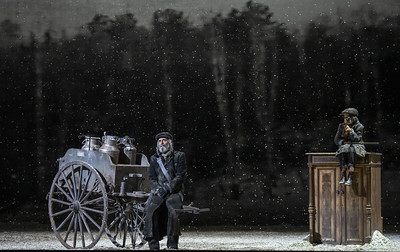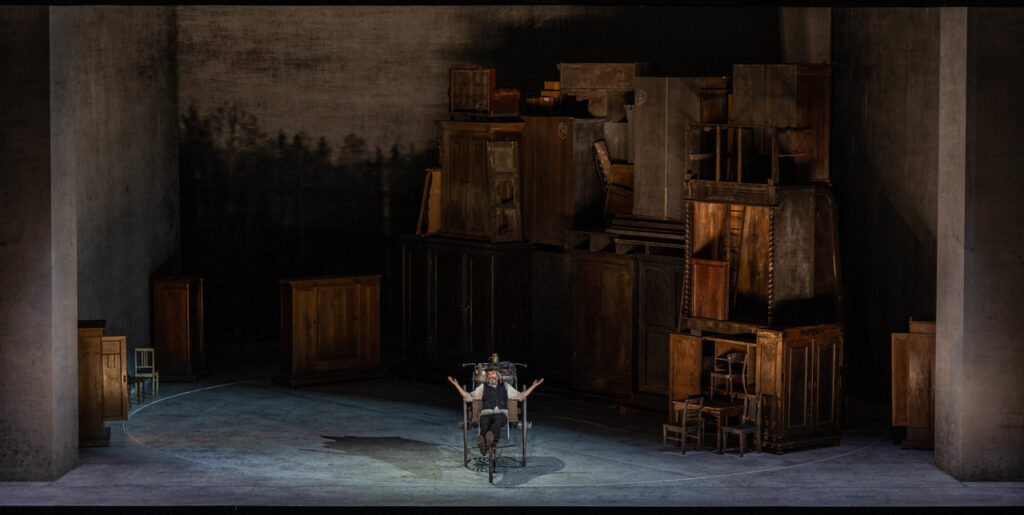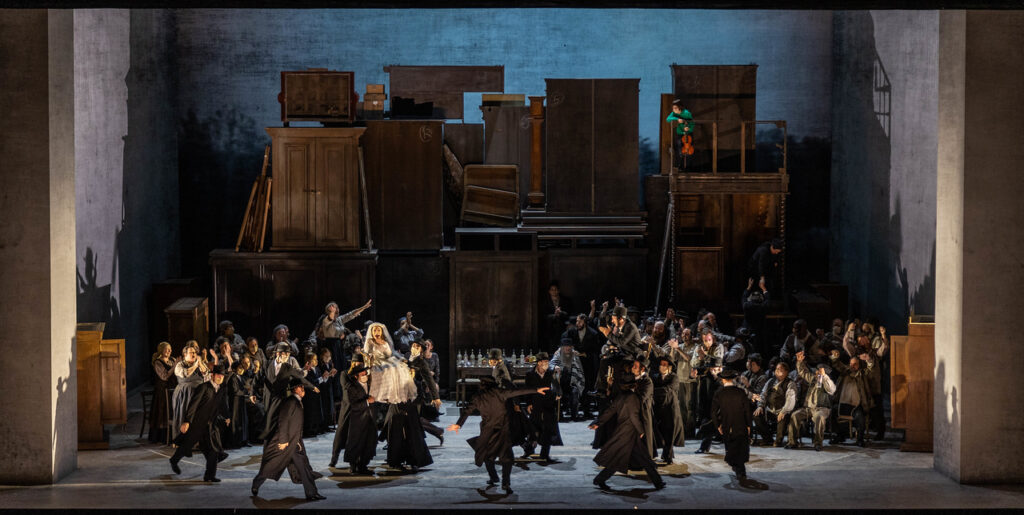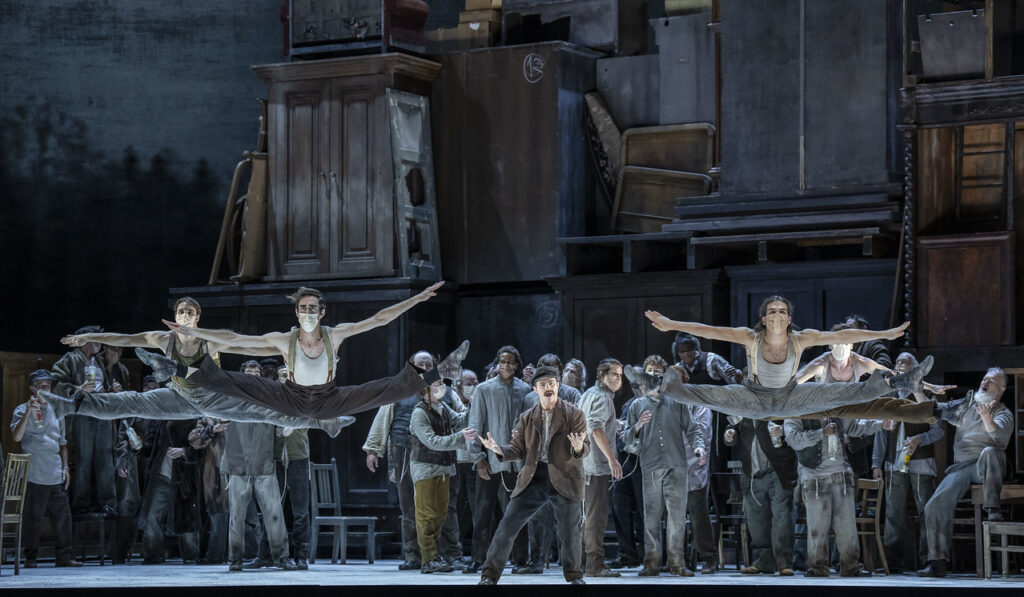
Lyric Opera of Chicago presents the United States premiere of a production by Komische Oper Berlin FIDDLER ON THE ROOF.
Tradition. Tradition….. Tradition! A Jewish man grapples with religious customs, political oppression and the independence of his grown-up daughters. He asks God for guidance in making life decisions. The familiar story, based on Sholem Aleichem stories with book by Joseph Stein, is anchored in heritage, humor and heart. The musical with its beloved score, by Jerry Bock (music) and Sheldon Harnick (lyrics), debuted nearly sixty years ago to critical and popular acclaim. Both its theatrical and cinematic productions garnered mega accolades including multiple Tony and Oscar Awards. I’ve personally seen several staged performances, worn out the movie video tape and sang to the cast recording enough times that I could easily understudy any part.
This production is my favorite!
Director Barrie Kosky masterfully navigates between the old/new, drama/comedy and complexity/simplicity. In a contemporary spin, he uses a fifth grader, Drake Wunderlich, as the fiddler. The show starts with the young boy, in headphones and hoodie, opening an ancient wardrobe and finding a violin among the coats and suitcase remnants. As Wunderlich begins to play so beautifully, the door -literally- opens to the past and the very large cast spills out.
 Set Designer Rufus Didwiszuz has cobbled together an oversized pile of wardrobes, tables and other furniture to create a makeshift shtetl (village). All of the pieces have been collected from second- and third-hand stores in East and West Berlin. Kosky cleverly uses the heap of rubbish for entrances/exits. The performers climb in and out of various -seemingly precariously stacked- wardrobes. It’s transfixing! In “Matchmaker Matchmaker”, a revolving line of suitors arrive to delight and disgust the would-be-brides. Later during the wedding scene, the wardrobe doors open and the bride and groom are showcased in a lit-up framed box. The set is on a revolving stage with all sides of the stockpile used efficiently and amazingly to transition scenes. In the second act, the chaotic mound is replaced by a single wardrobe as snow falls continuously on the stark stage. This set is the perfect storytelling visual.
Set Designer Rufus Didwiszuz has cobbled together an oversized pile of wardrobes, tables and other furniture to create a makeshift shtetl (village). All of the pieces have been collected from second- and third-hand stores in East and West Berlin. Kosky cleverly uses the heap of rubbish for entrances/exits. The performers climb in and out of various -seemingly precariously stacked- wardrobes. It’s transfixing! In “Matchmaker Matchmaker”, a revolving line of suitors arrive to delight and disgust the would-be-brides. Later during the wedding scene, the wardrobe doors open and the bride and groom are showcased in a lit-up framed box. The set is on a revolving stage with all sides of the stockpile used efficiently and amazingly to transition scenes. In the second act, the chaotic mound is replaced by a single wardrobe as snow falls continuously on the stark stage. This set is the perfect storytelling visual.
Onto the stage, Kosky adds huge amounts of humanity. When all the actors, dancers, and chorus are onstage, it looks like a village of a hundred. Costume Designer Klaus Bruns dresses them with authenticity. Drab colors and dirty garments showcase the gritty reality. Bruns, along with Wigmaster and Makeup Designer Sarah Hatten, distinguish the Russian soldiers from the Jewish community by cladding them in muscle shirts and handlebar mustaches. Combined with Didwiszuz’s dreary backdrops, the poverty and despair is palpable and gut-punching. This is especially apparent when Kosky ends Act 1 with unforgettable turmoil followed by unnerving silence.
 Still, Kosky’s ensemble captures the love and laughter among the rubble. Moments of true joy and passion coexist with life and loss. In the lead, Steven Skybell (Tevye) is excellent as the papa! Whether belting out the song or contemplating the right choice, Skybell plays it with honest sincerity and good-natured resignation. The entire talented cast and chorus lend their passion and voices to the storytelling. Conductor Kimberly Grigsby sets the tempo and the tone. With the strength of the LO orchestra behind her, the music is exquisitely haunting. The well-known melodies float up from the pit, intertwine in harmony onstage, and then awash the audience in an emotional remembrance. I found my eyes continually damp from the beautiful music describing life complications.
Still, Kosky’s ensemble captures the love and laughter among the rubble. Moments of true joy and passion coexist with life and loss. In the lead, Steven Skybell (Tevye) is excellent as the papa! Whether belting out the song or contemplating the right choice, Skybell plays it with honest sincerity and good-natured resignation. The entire talented cast and chorus lend their passion and voices to the storytelling. Conductor Kimberly Grigsby sets the tempo and the tone. With the strength of the LO orchestra behind her, the music is exquisitely haunting. The well-known melodies float up from the pit, intertwine in harmony onstage, and then awash the audience in an emotional remembrance. I found my eyes continually damp from the beautiful music describing life complications.
Along with the sentimental history lesson, ongoing levity arrives in the dance. The dancing is mesmerizing. Building off the original choreography by Jerome Robbins, Choreographers Otto Pichler and Silvano Marraffa add in their own flair with athleticism and distinctive movements. The traditional hora, squat kicking, kneeling-n-sliding are accompanied by modern twists. The nimble dancers flex their hands and contort their torsos in spellbinding synchronicity. During the dance-off between the Jewish people and the Russians, I’m rooting for both sides. The dancing is impressive!
The score, the singing, and the dancing are fabulous! I loved this experience. And the story is so compelling. Although this iconic show is set in 1905, the music and story feel timeless especially given the recent Russian invasion of Ukraine. The past feels present as people are persecuted for their difference and beliefs. Life imitating art. Art imitating life. Powerful!
Running Time: Three hours and half hours includes a thirty minute intermission
Lyric Opera of Chicago, 20 N. Upper Wacker Drive
Based on Sholem Aleichem stories by special permission of Arnold Perl
Book by Joseph Stein
Music by Jerry Bock
Lyrics by Sheldon Harnick
Original New York Stage Production directed and choreographed by Jerome Robbins
Conducted by Kimberly Grigsby
Directed by Barrie Kosky
Original Choreography by Otto Pichler
Revival Choreography by Silvano Marraffa
September 22nd, 23rd, 30th and October 6th, 7th at 7pm
September 23rd at 10am
September 24th at 7:30pm
September 28th, 29th and October 2nd at 2pm
Thru October 7th
For more information or tickets
Photos by Todd Rosenberg
For more Chicago theatre information and reviews, please visit Theatre in Chicago
